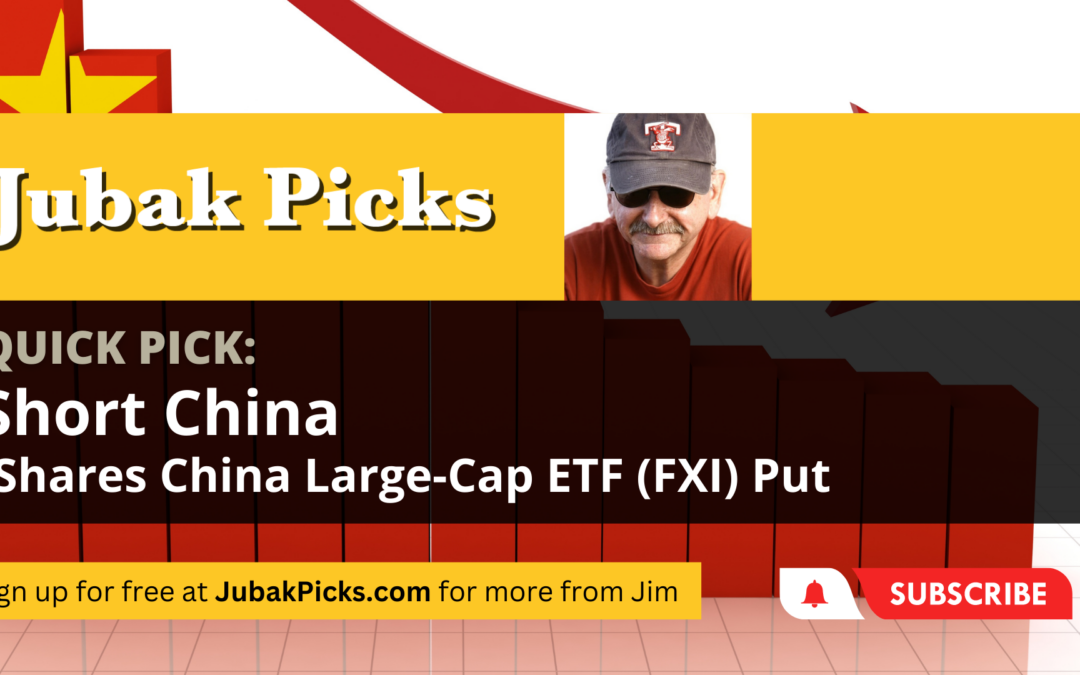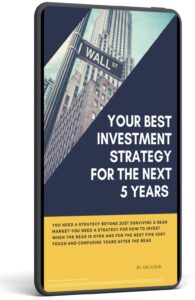
October 2, 2023 | Daily JAM, NVDA, Volatility |
I’m going to take advantage of today’s pop in Nvidia (NVDA) to sell the shares out of my very short-term Volatility Portfolio tomorrow, Tuesday, October 2. The shares closed up at the close today at $447.82, a gain of 2.95% on the day. I initiated the position in the Volatily Portfolio on Mach 25, 2023. It was up 66% as of the close today So why sell Nvidia here?

September 26, 2023 | AAPL, ADBE, ALB, AMAT, EUM, GOLD, LAC, Morning Briefing, MSFT, NVDA, PILBF, RWM, SCCO, Short Term, Special Reports, UUP, Volatility |
So what do you do with your portfolio for the rest of 2023? And what’s your best strategy to be prepared for 2024? In Part 1 of this Special Report I laid out the 10 developments that I thought would drive the financial markets for the rest of 223 and into 2024. Today, in Part 2, I’m going to give you the first 2 of 10 moves to take–with as much detail and as many specifics as possible–that you should be making now to position your portfolio for the uncertainties of the last quarter of 2023.

September 20, 2023 | Daily JAM, Volatility |
The CBOE Volatility Index, which measures short-term volatility in the Standard & Poor’s 500 stocks, has been stuck below its long-term average of near 17 since the regional bank crisis of March 2023. In recent months, the VIX has had a hard time breaking above 17 with the index spending most of its time down about 15. Today, at 1 p.m. New York time, the VIX was at just 14.01, down 0.71% ahead of the Federal Reserve’s interest rate decision. There’s just no fear in this market. So it will extremely interesting to see if today’s interest rate decision and the release of new Dot Plot forecasts for interest rates, inflation, economic growth, and unemployment today from the Fed has any effect of market complacency.

September 7, 2023 | Daily JAM, Jubak Picks, USO, Volatility |
Tomorrow September 8, I’m selling shares of U.S Oil Fund (USO) out of my Jubak Picks ad Volatility Portfolios to take profits on the 25% really in oil since June and to raise some cash in case September volatility delivers a bargain or two.

June 28, 2023 | Daily JAM, LNG, UNG, Volatility |
Today’s video is The Long Hot Summer and Natural Gas. If you’ve been following the weather, you know about the huge heat bubble in Texas where temperatures have reached 120 degrees. High temperatures combined with humidity of around 80% can cause serious health problems and even death. The National Weather Service expects this weather to continue and to spread to other parts of the United States, resulting in more and more people staying inside with the air conditioning cranked all the way up. This spike in temperatures is creating a similar spike in natural gas prices. On June 26, we hit a 16-week high for natural gas prices, and July natural gas futures (for July delivery) have been up 14 out of the last 17 sessions. This price surge has two causes ad is operating on two time frames. In the immediate term, the increased air conditioning use stresses the grid, leading to a reliance on natural gas back-ups to supply the energy needed to cover these demand peaks. This, of course, creates a lot more demand for natural gas in the short term. The second thing is a surprising change in long-term thinking about the future of natural gas. I’m seeing a new wave of 20-year supply contracts from places like China and Japan, suggesting countries are thinking that natural gas has a longer future as a transitional fuel as the world moves toward more sustainable energy sources. The two stocks I would look at here are Cheniere Energy, (LNG) and United States Natural Gas Fund, (UNG). Cheniere is up 6% in the last month and is a good way to play the long-term trend in natural gas use. UNG hit a potential bottom in June and is up 16% in the last month. The bigger gain is a result of the ETF being hammered due earlier in the year. UNG is a far more volatile buy, with much higher risk, so if you’re uncomfortable with risk, stick with the more modest but more predictable gains from Cheniere.

June 27, 2023 | Daily JAM, GNRC, LNG, Volatility |
Heat advisories now stretch from northern Florida to southern New Mexico, and excessive-heat warnings have been issued for much of Texas and parts of New Mexico and Arizona and along the Gulf Coasts of Louisiana, Mississippi and Alabama. New Orleans is included in the zone of greatest heat risk, with actual air temperatures around 100 degrees and humidity that will push heat indexes to 115 degrees. Excessive-heat watches have been posted for the lower Mississippi Valley and include Memphis and Nashville; Huntsville and Birmingham; Jackson, Mississippi; Little Rock, Arkansas; and Poplar Bluff, Missouri. “Extreme heat and humidity will significantly increase the potential for heat-related illnesses,” cautioned the National Weather Service, “particularly for those working or participating in outdoor activities.” The heat will relent somewhat into early next week for portions of the Southeast and Mid-South, but there is no immediate end in sight for Texas, where blistering and brutal conditions look to continue as a heat doe lingers over Texas. And this is only the latest U.S. manifestation of a global problem.

June 22, 2023 | Daily JAM, GNRC, Short Term, Volatility |
I’ve got major questions about Generac’s (GNRC) long-term growth. The company, the dominant player in the market for residential backup electric generators (with about 4 times the market share–or about 75% of the market–of its nearest competitor) faces big questions, in my opinion, about its long-term strategy and its ability to grab significant revenue in the clean energy market where it faces competition from larger companies, more established in the market, such as SolarEdge (SEDG) and Enphase (ENPH). But in the short run? Say, the next two or maybe three (at the outside) months, I say this is a stock that will ride summer storms and heat waves to gains. Especially, if as I project, the company delivers lackluster quarterly earnings when it reports on August 2, but gives very positive guidance for the next quarter or two

June 1, 2023 | AMAT, AMD, CVS, Daily JAM, Dividend Income, EMR, GOOG, ILMN, Jubak Picks, Long Term, MSFT, NVDA, Top 50 Stocks, TSM, Volatility |
Artificial intelligence really is a paradigm-breaking, transformative technology. Right now, investors are so enthusiastic about the sector, especially the obvious leader Nvidia (NVDA), that we’re looking at a potential bubble that will collapse with much gnashing of teeth and I-told-you-so “wisdom” casting doubt on the reality of the entire endeavor. I think a bubble is indeed possible. Nvidia did trade at a trailing twelve-month price-to-earnings ratio of 196 on May 31, after all. But I think you do want to own the sector now–because the breaking of the bubble, if it does break is, in my opinion, two quarters or more away. And you want to own the sector for the long run–say, 10 years or more–because it is such a game changer for so much of the economy. But what to own? I’ve put together a list of the 10 stocks that I think are the best way to participate in the AI gold rush.

May 30, 2023 | Daily JAM, Perfect Five-ETFs, Videos, Volatility |
Today’s Quick Pick is Short iShares China Large-Cap ETF (FXI) COVID is back in China with a new peak of an estimated 65 million cases a week. It’s not as bad as the last peak which saw 35 million cases a day, but it’s enough that the economy will take a hit. And China’s reopening recovery was already looking a bit shaky. During the last wave of COVID, the iShares China Large-Cap ETF (FXI) fell to $20.95. The ETF rose steadily from that low on optimism over China opening back up. The economy didn’t bounce back as quickly as expected and FXI has stayed in the $27-$28 range recently. My suggestion is to buy an August Put Option. That will leave enough time for the COVID wave to play out. The August 18 Put with a strike price of 27, trades at just $1.00 or $100 for a contract of 100 shares of the ETF. That price makes this an affordable volatility play on a macroeconomic trend, and I’ll be adding this to my Volatility Portfolio portfolio on my paid site, JubakAM.com, and selling this ETF out of my Perfect 5 ETF Portfolio.

May 24, 2023 | Daily JAM, NVDA, Top 50 Stocks, Volatility |
Nvidia (NVDA) shares were up 19.68% at 4:45 p.m. New York time today, May 24, after the company reported beating analyst estimates on earnings and revenue. The company also told analysts to expect second-quarter revenue way, way above pre-announcement projections. For the three-month period ending April 30, Nvidia earned $1.09 per share, excluding one-time items, as revenue came in at $7.19 billion. Analysts were looking for the company to report earnings of 92 cents a share and $6.28 billion in revenue.

May 1, 2023 | Daily JAM, KRE, Special Reports, Volatility |
JPMorgan Chase’s (JPM) deal today, Monday, May 1, to acquire First Republic Bank (FRC) after the Federal Deposit Insurance Corporation (FDIC) regulators seized the bank certainly puts an end to the First Republic chapter of the banking crisis. But there are lots of chapters to go in this banking crisis. So my second short for this market is to buy Put Options on the SPDR S&P Regional Banking ETF (KRE).

April 14, 2023 | Daily JAM, Short Term, Volatility |
The VIX “fear index,” known more formally as the CBOE S&P 500 Volatility Index (VIX), dropped again today with a retreat of 3.60% taking the index down to a close of 17.16. The VIX, which measures the price that investors and traders are willing to pay in the options market to hedge risk on the Standard & Poor’s 500 in the next month or so, hasn’t been this low in 2022. The prior low for the VIX this year was 17.87 on February 2. You have to go back to December 27, 2021, when the index stood at 17.22 to find a roughly comparable level. With all that lurking out there in the financial world, I find the VIX at 17.16 too good to pass up.















